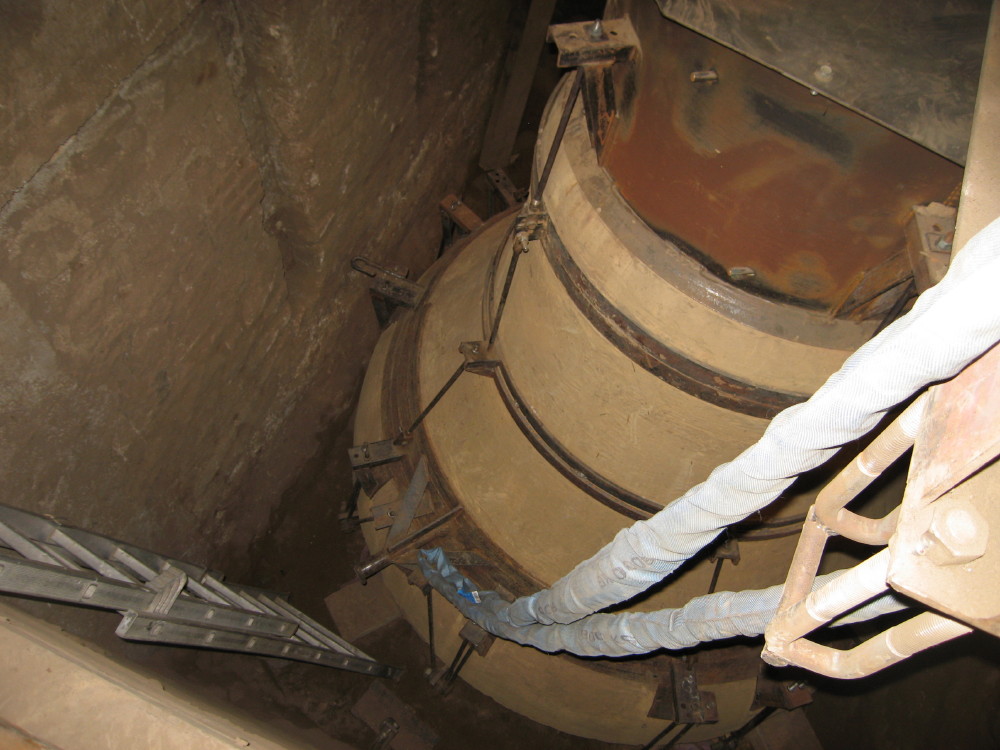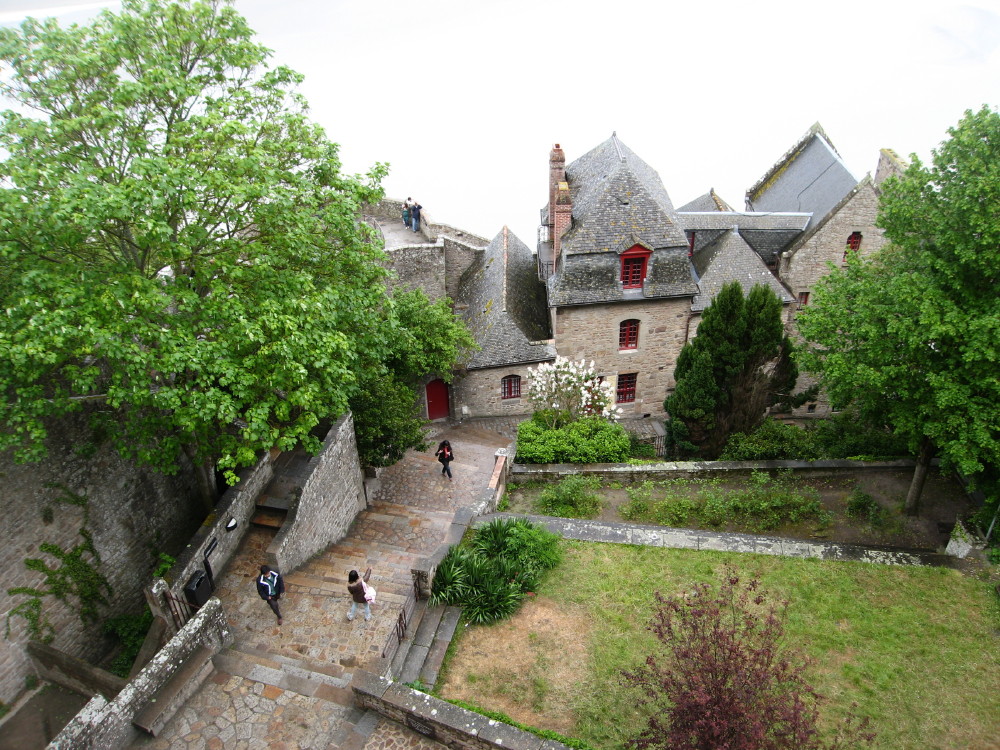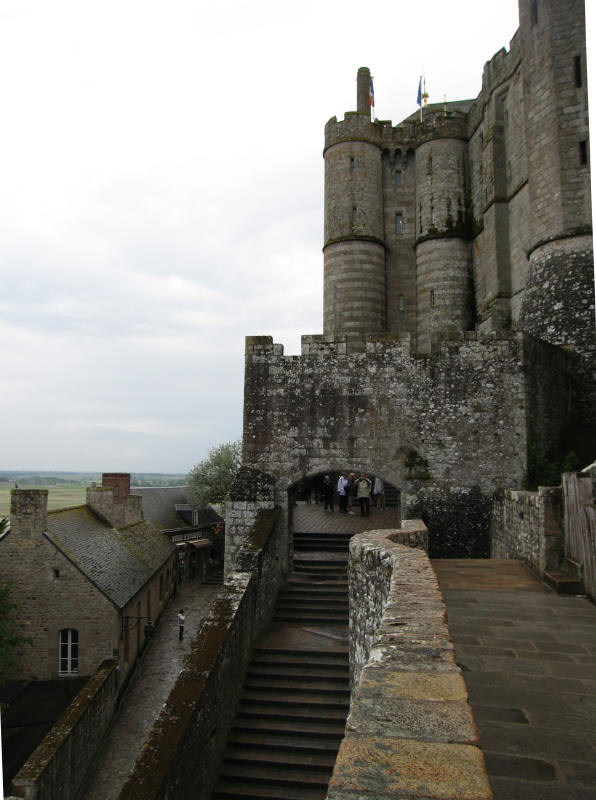
Normandy, France (cont'd)
May 24-29, 2010
Villedieu-les-Poêles
This small town, whose name means 'City of God the frying pans,' has a brass bell foundry that still produces bells in much the same way they have for centuries. We visited this factory. The visit takes you right into the working factory, so you get to see whatever is going on at the time.

Some small bells on a shelf.

These workers had just removed a bell from its mold. It is attached to a crane to help move it around. You can see the chain.
This photo shows most of the foundry. I'm standing near the front looking toward the back. There is a furnace to the left and a smaller one at the back under that hood. Behind the furnace on the left are two large pits. The molds are made of clay and clay mixed with horsehair and horse manure. A layer of wax between the inner and outer molds melts away when the clay is fired leaving space for the molten brass to be poured into.

The inside of a mold. I believe this is a fired clay mold, that has not been used yet. The date inside reads June 6, 2010.

A very large mold. This is for a bell that will go to Mulhouse, France--to the cathedral there, I think. It was really big. You can see the ladder on the left that goes down into the pit. They would fill this pit with dirt to keep the heat uniform inside. There was another pit next to it that holds the dirt when this one is empty. This mold will be flipped upside down and then filled with molten brass from the oven.

A bell waiting for final polishing. It will go to Vietnam. It has been mounted so that it can be rung by pulling a rope. The clapper appears to be sitting beside it.
Avranches
This town on the coast of Normandy overlooks the island of Mont-Saint-Michel.

American General Patton came through Avranches during the 1944 liberation of France from the German occupation.

The 19th century neo-gothic cathedral of Notre-Dame-des-Champs
And its interior.
It was in Avranches that Henry II of England did public penance for the execution of Archbishop Thomas Becket of Canterbury.
Mont-Saint-Michel
This was the most touristy place we visited, but Mont-Saint-Michel deserves it's reputation as an interesting medieval town in spite of the commercialism that has invaded the old town.
Originally an island during high tides, you can now walk to the town by the causeway. There are no cars on the island, however.
The streets are narrow and wind up toward the abbey at the top of the town. I spotted this post office near the entrance to the town and went inside to buy another stamp, after having bought another post card in the shop next door. The official asked me if I wanted to seal it up, but I said no, as I again hadn't written the post card yet. He put the stamp on the outside of the envelope for me and post-marked it. I wonder how he knew I had a problem with getting stamps on the outsides of envelopes.

We found some less used stairs and climbed up towards the abbey by a side route instead of by the busier road.

A garden and some more steps.

Some of the outer ramparts.
Looking out towards the English Chanel at low tide.

More of the outer walls and buildings.
The steps we had just come down.
Looking up towards the abbey.
Before we left the island we sat in a cafe and I wrote my postcard, put it in the envelope and dropped it in the mail slot. I was pretty sure I'd done everything right this time. Mailing a post card is so much more complicated than most people think. There are just so many steps, which is why I don't do it much.
Roche d'Oëtre
One day we got out of the towns and went for a hike in the park around the rock formation called Roche d'Oëtre

The parking lot is at the top, so we hiked down this trail to the river below.
The trail was pretty rocky,
and led down to the river Rouvre.
We ate our picnic lunch on this rock. There weren't any tables along the trail, but there weren't any other people here either.
I believe this is the plant called "broom" in English, "planta genista" in Latin and "genêt" in French and from which the Plantagenet Kings get their nickname. Supposedly Geoffroy d'Anjou wore a sprig of it in his hat. It grows well on rocky hillsides throughout northern Europe.
____________________________________________________________
After getting back home I went to the school where I meet Nicole, the girl to whom I had addressed the post cards. She didn't mention any post card, so I asked if she had received a post card from me. She said yes, she had gotten 2 of them! I asked to see them and she had both post cards and both envelopes in her backpack. Sure enough the first envelope had no stamp on the outside, but two on the inside. Both the French and American postal services had delivered this letter with no visible postage!